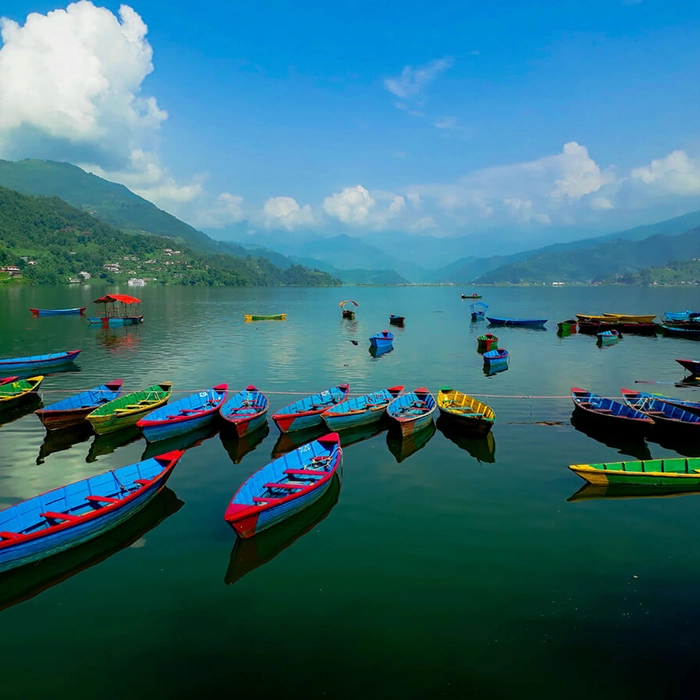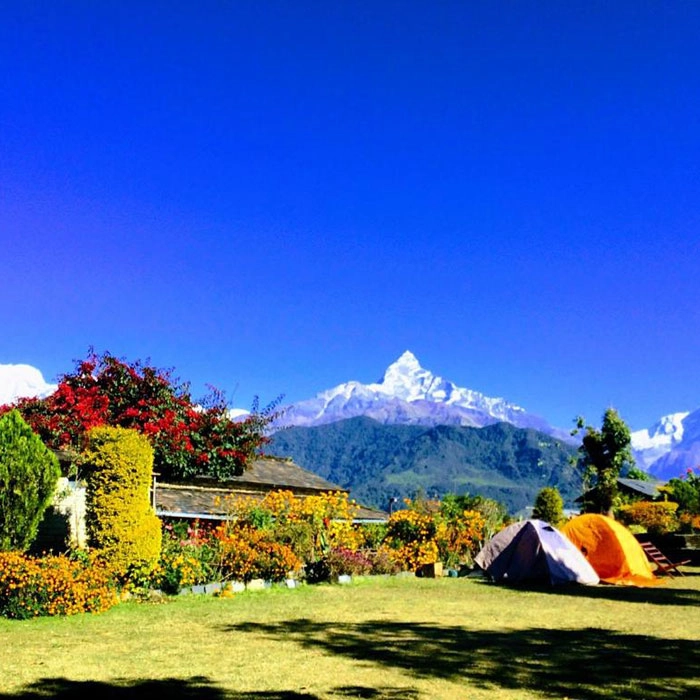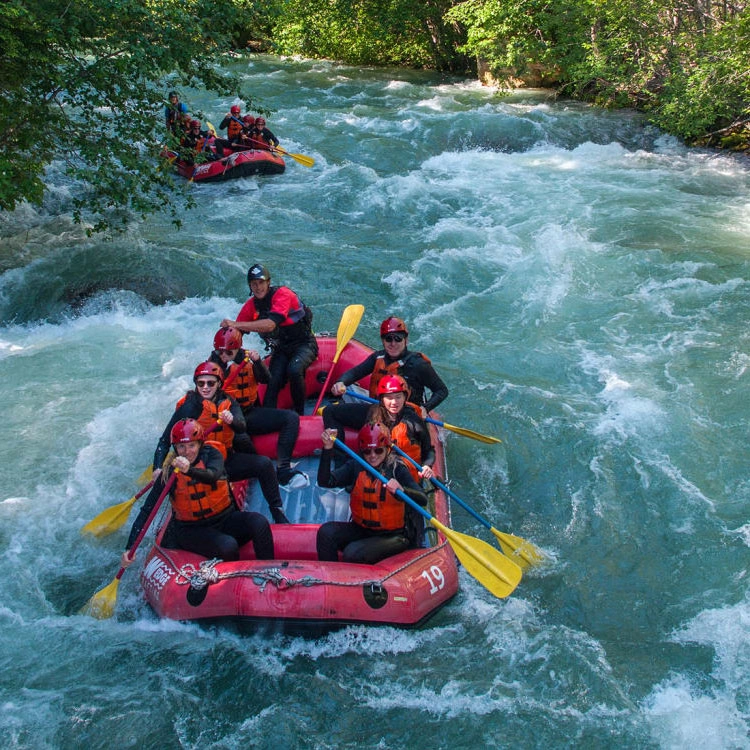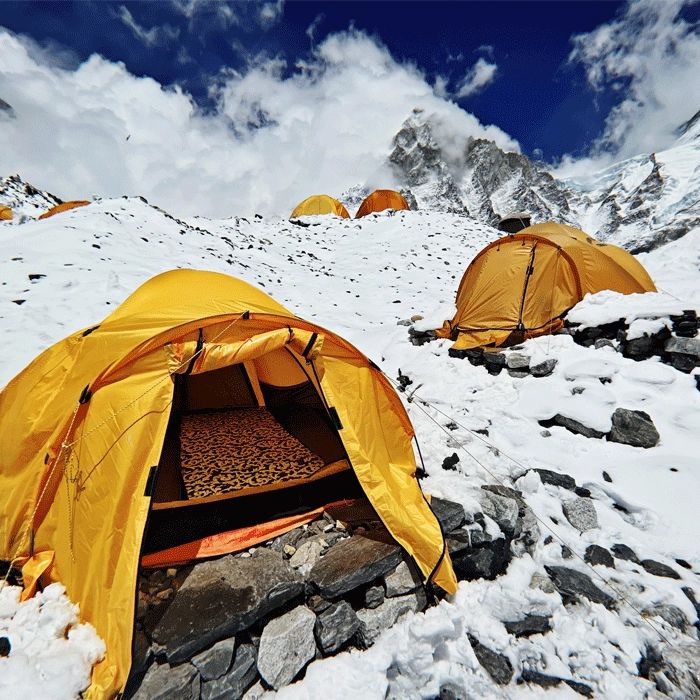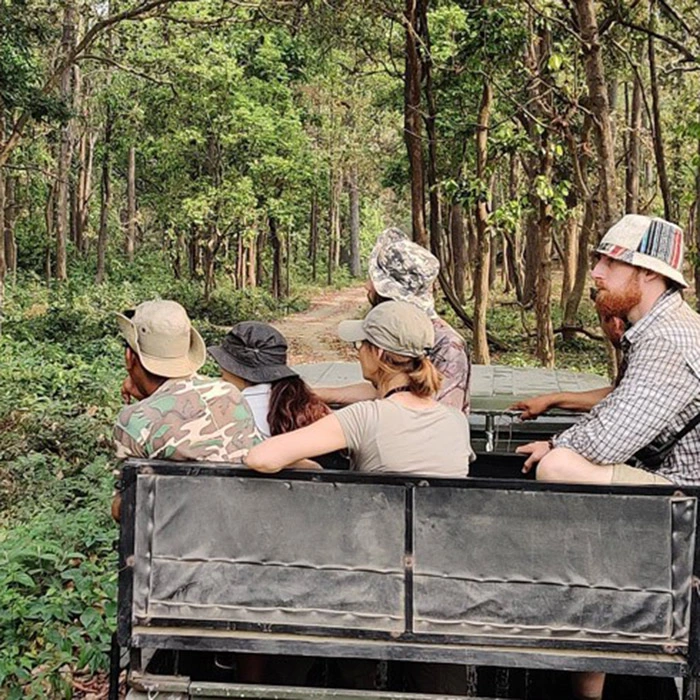GHOREPANI POON HILL TREK
US$1,980.00
/pp
-
14 Days
-
Annapurna
-
Spring/Autumn
-
Trekking
-
3,210 Meters
-
Easy
-
Bus / Plane
-
01-16 People
-
JH#219
 Overviews
Overviews
Embark on the Ghorepani Poon Hill Trek in Nepal, a renowned adventure also known as the Poon Hill Trek. This trek is celebrated for its breathtaking scenery and accessible routes. As you journey through picturesque villages and vibrant rhododendron forests, you will experience the pristine beauty of Nepal’s landscapes up close. The trek culminates at Poon Hill, which stands at 3,210 meters. From this viewpoint, you will enjoy expansive views of the majestic Annapurna and Dhaulagiri mountain ranges. Throughout the trek, you’ll stay in comfortable tea houses, ensuring a cozy and authentic experience while immersing yourself in the region’s vibrant culture and diverse wildlife. Elevate your adventure with a 2-night, 3-day Chitwan Jungle Safari. This extension allows you to explore Chitwan National Park, renowned for its rich biodiversity. Engage with the local Tharu community through guided tours and learn about their traditions and lifestyle. In the park, you may spot rare wildlife, such as the Bengal tiger and the one-horned rhinoceros. The lush scenery and abundant wildlife make this safari a memorable highlight of your journey. Conclude your Ghorepani Poon Hill trek with guided tours of the seven UNESCO World Heritage Sites in the Kathmandu Valley. Immerse yourself in Nepal’s rich history and marvel at its architectural treasures. Visit ancient temples, stupas, and palaces, each offering unique insights into Nepal’s cultural heritage. Enjoy spectacular views from Swayambhunath (Monkey Temple), admire the intricate artistry of Patan Durbar Square, and experience the serene ambiance of Boudhanath Stupa, one of the world’s largest stupas. Ghorepani Poon Hill Trek blend of trekking, wildlife exploration, and cultural discovery provides a perfect combination of adventure and enrichment. With Jagadamba Holidays, experience the best of Nepal—from the scenic trails of Poon Hill to the cultural wonders of Kathmandu Valley and the wildlife of Chitwan. Ghorepani Poon Hill Trek DifficultyThe Ghorepani Poon Hill Trek is a beginner-friendly trek and at best a moderate difficulty level trek, thus making it ideal for first-time trekkers and families who wants to experiecne hiking. The trail involves daily walks of 4–6 hours through well-established paths, stone steps, and gradual ascents. While no technical climbing is required, you should have a basic level of fitness to comfortably handle uphill sections, especially the climb to Poon Hill for sunrise. With proper pacing and acclimatization, most people who are in good health can complete this trek without difficulty. Short & Flexible Poon Hill Trek in AnnapurnaExperience the optional Short Poon Hill Trek, a flexible and easy Annapurna trek ideal for stunning Himalayan sunrise views. This popular Nepal trekking route can be completed in 3, 4, or 5 days, with shorter itineraries requiring longer daily hikes to complete the full Poon Hill circuit. Trek through traditional villages like Ghorepani and Ulleri, and enjoy breathtaking panoramic views of the Annapurna and Dhaulagiri mountain ranges from Poon Hill (3,210m). Perfect for beginners and travelers short on time, this short Nepal trek offers a quick yet unforgettable Himalayan adventure. Ghorepani Poon Hill Trek CostThe Ghorepani Poon Hill Trek offers exceptional value for both solo trekkers and groups. The cost typically covers all essential services, including a licensed trekking guide, porter assistance, accommodation in traditional tea houses, all meals during the trek, required permits, and ground transportation. Solo travelers can enjoy personalized attention and full support, while groups benefit from attractive discounts, with the cost per person decreasing as group size increases. We also provide special seasonal offers during the low trekking seasons, making this scenic Himalayan journey even more affordable. Whether you're traveling alone or with a group, this short and rewarding trek fits a wide range of budgets and expectations. While the prices listed on our website reflect general global rates, custom pricing is available for private groups. If you're planning a trek with friends, family, or a custom group, feel free to contact us directly — we’re happy to provide a tailored quote. We proudly offer the lowest possible price without compromising on quality, ensuring the highest standard of service throughout your himalaya journey in Nepal.
 Itinerary (Plan)
Itinerary (Plan)
Arrive in Kathmandu (1,400 m / 4,593 ft.), Nepal's vibrant capital, where you'll be warmly welcomed with marigold garlands. After transferring to your hotel, take time to relax and acclimate to the bustling city. Discover vibrant local markets, indulge in traditional Nepali dishes, and delve into Kathmandu's rich cultural tapestry. This initial day is perfect for easing into your journey, setting the stage for the exciting adventures ahead in Eastern Nepal. A representative from Jagadamba Holidays will ensure a smooth and pleasant arrival.
Optional Evening Activity:
If you wish, you can spend your evening experiencing the Pashupatinath Aarti, a captivating religious ceremony held at the Pashupatinath Temple. The Aarti usually begins around 6:00 PM and lasts for approximately an hour. This ceremony is a mesmerizing display of traditional music and rituals, providing a profound insight into Hindu spiritual practices. Please check the exact time for the Aarti on the day of your visit, as it may vary. This option is not included in the standard itinerary but offers a unique opportunity to immerse yourself in local culture.
Begin your cultural exploration of the Kathmandu Valley at 9 AM with a visit to Patan Durbar Square, renowned for its stunning Newari architecture and historic temples. Continue to Bhaktapur Durbar Square, famous for its medieval charm, exquisite palaces, and the iconic 55-Window Palace. Conclude your day with a visit to Changu Narayan Temple, one of Nepal's oldest Hindu temples, offering rich historical significance and panoramic views of the surrounding valley. This itinerary provides a comprehensive glimpse into Nepal’s architectural heritage and spiritual history.
Patan Durbar Square:
Patan Durbar Square, situated in the heart of Lalitpur, is a remarkable showcase of Newari architecture and culture. This historic square is renowned for its intricate temples, ornate wooden carvings, and beautifully preserved courtyards. Among its most notable structures are the Hiranya Varna Mahavihar, a stunning golden temple, and the Mahabouddha Temple, which resembles the Mahabodhi Temple of Bodh Gaya. The square's centerpiece is the impressive Patan Palace, which houses the Patan Museum, offering a deep dive into Nepalese art, history, and culture.A walk through Patan Durbar Square offers a vivid insight into the Newar culture, where history, spirituality, and artistry converge in a truly captivating environment.
Bhaktapur Durbar Square:
Bhaktapur Durbar Square, a UNESCO World Heritage Site, is an extraordinary example of medieval Newar architecture and urban planning. This historic square is renowned for its majestic temples, palaces, and monuments, each showcasing exquisite craftsmanship. The 55-Window Palace stands out with its intricate wooden windows and rich history, while the Vatsala Temple and Siddhi Lakshmi Temple display elaborate carvings and sculptures. The square also features the iconic Nyatapola Temple, a five-story pagoda dedicated to Siddhi Laxmi, the goddess of prosperity. The dynamic ambiance of Bhaktapur Durbar Square, enhanced by its exquisite artisanal crafts and traditional pottery, affords a profound insight into Nepal's rich cultural and historical heritage.
Changu Narayan Temple:
Changu Narayan Temple, perched atop a hill in the Kathmandu Valley, is one of Nepal’s oldest and most revered Hindu temples. Dedicated to Lord Vishnu, this ancient temple dates back to the 4th century and is celebrated for its rich history and exquisite artwork. The temple complex features intricate carvings, vibrant sculptures, and ancient inscriptions that reflect the artistic prowess of the time. The surrounding area offers panoramic views of the Kathmandu Valley, enhancing the spiritual ambiance of the site. Changu Narayan Temple serves as a living testament to Nepal’s Hindu heritage, with its serene environment and historical significance making it a must-visit destination for those interested in the country’s cultural roots.
Your day begins with a scenic flight from Kathmandu to Pokhara (822 m / 2,697 ft), usually lasting about 25–30 minutes. The takeoff provides a thrilling view of the Kathmandu Valley below, while the flight path offers stunning aerial panoramas of the Himalayas, including the Annapurna and Dhaulagiri ranges. As you approach Pokhara, marvel at the stunning lakes, terraced hills, and meandering rivers below. The landing is smooth, giving you your first on-ground experience of the serene Pokhara valley.
After landing, meet your guide and trekking team, then begin a picturesque drive to Hile Village (1,430 m / 4,692 ft). The scenic drive to Hile winds through lush green valleys, vibrant terraced fields, and traditional rural villages, offering travelers a glimpse of authentic Himalayan village life. Along the way, you’ll pass Birethanti (1,025 m / 3,363 ft), local markets, traditional houses, and small rivers, capturing the essence of Nepalese village life. The scenic journey offers several viewpoints perfect for photos, making it a memorable start to your trek.
The trek from Hile to Ulleri (1,960 m / 6,430 ft) covers approximately 3 km (1.9 mi) and usually takes 3–4 hours, leading trekkers through forested slopes, terraced farmland, and quaint villages while gradually ascending to Ulleri at 1,960 m (6,430 ft). During this section, you’ll ascend about 550 m and descend roughly 10 m. The trail starts with a steady climb through hills and villages, gradually gaining elevation. The final stretch to Ulleri (1,960 m / 6,430 ft) features a steep ascent via stone steps, offering an invigorating introduction to the trekking adventure ahead. Ulleri, in the Annapurna region, is a refreshing rest stop for trekkers with cozy teahouses and warm local hospitality.
Along the trail, you’ll pass terraced fields, forested slopes, and traditional villages, experiencing the daily life of local communities. Observe farmers at work, visit small temples, and enjoy glimpses of local culture. Upon reaching Ulleri, take in panoramic views of Annapurna South and Hiunchuli peaks, while soaking in the tranquil Himalayan environment and preparing for the days of trekking ahead.
After breakfast at the lodge in Ulleri, the trek continues toward Ghorepani (2,860 m / 9,383 ft), following one of the most scenic sections of the Annapurna trail. The path initially passes through quiet forested slopes, where tall rhododendron trees line the trail, bursting into vibrant colors during spring. Trekkers also walk past terraced fields cultivated by local farmers, traditional stone houses, and small village temples, offering insight into the daily lives and cultural practices of the Gurung and Magar communities. Along the way, there are several viewpoints that showcase sweeping panoramas of the Annapurna and Dhaulagiri ranges, with snow-capped peaks visible in the distance. Small streams and waterfalls occasionally cross the trail, adding to the scenic charm of the journey.
The trek from Ulleri to Ghorepani spans approximately 8 km (5 mi) and generally takes 4–5 hours. During this section, trekkers ascend around 840 m (2,756 ft) and descend roughly 30 m (98 ft). The trail features a mix of gentle inclines and steeper forested stretches, gradually gaining elevation as trekkers move through shaded woodland and open hilltops. The well-marked route offers a balance of physical challenge and natural beauty, making it accessible for moderately experienced trekkers while allowing plenty of opportunities to pause for photographs or rest.
As trekkers reach Ghorepani, the village welcomes them with cozy teahouses and lodges, perfect for relaxation after the day’s climb. From this vantage point, panoramic views of Annapurna South, Hiunchuli, and Dhaulagiri peaks dominate the skyline. The surrounding forests are rich with flora, including rhododendrons, oaks, and ferns, while the air carries the subtle scents of pine and earth. Villagers in Ghorepani maintain traditional lifestyles, and visitors can observe local farm work, interact with families, or explore small community temples. The combination of spectacular landscapes, cultural experiences, and serene Himalayan environment makes Ghorepani an ideal rest stop, setting the stage for the next day’s trekking adventure.
Wake up early to hike to the iconic Poon Hill (3,210 m), one of the most sought-after viewpoints in the Annapurna region, offering breathtaking sunrise views and unforgettable Himalayan panoramas. The hike is approximately 2.75 km (1.7 mi) round trip, taking 1.5–2 hours with a 270 m (886 ft) ascent and descent. From the summit at 3,210 m / 10,531 ft, witness the first golden rays illuminating the Annapurna, Dhaulagiri, Machapuchare (Fishtail), and Nilgiri peaks, offering unparalleled panoramic vistas. This unforgettable sunrise experience highlights the majesty of the Himalayas and provides endless photo opportunities for trekking enthusiasts. Poon Hill is globally recognized as a must-visit sunrise destination in Nepal, attracting trekkers from around the world.
After witnessing the unforgettable Poon Hill sunrise (3,210 m / 10,531 ft), one of Nepal’s most iconic viewpoints offering panoramic vistas of Annapurna, Dhaulagiri, Machapuchare, and Nilgiri peaks, return to your lodge in Ghorepani for a hearty breakfast. Once refreshed, continue your Annapurna trekking adventure toward the tranquil village of Tadapani (2,630 m / 8,628 ft). The trail winds through lush rhododendron and oak forests, streams, waterfalls, and traditional villages, providing trekking enthusiasts with a perfect blend of natural beauty, cultural experiences, and sweeping Himalayan panoramas.
The trek journey from Ghorepani to Tadapani spans approximately 8 km (5 mi) and typically takes 5–6 hours, with an ascent of around 460 meters and a descent of roughly 650 meters. The trail begins with a gentle descent through dense rhododendron and oak forests, interspersed with streams, waterfalls, and shaded rest areas. Along the route, trekkers pass traditional Nepalese villages, stone houses, and terraced farmlands, offering a glimpse into authentic rural life and local culture. As the trail gradually ascends toward Tadapani, multiple scenic viewpoints provide sweeping Himalayan panoramas, including breathtaking views of the Annapurna and Dhaulagiri ranges. This section of the Poon Hill trek perfectly combines natural beauty, Himalayan vistas, and cultural experiences, making it a visually captivating and enriching experience for trekking enthusiasts exploring Nepal.
Upon arrival in Tadapani (2,630 m / 8,628 ft), unwind in cozy teahouses surrounded by serene forests and breathtaking Himalayan panoramas. Trekkers can observe local farming practices, interact with villagers, or simply soak in the tranquil environment. The combination of stunning landscapes, cultural experiences, and peaceful mountain ambiance makes Tadapani an ideal stop before continuing the Annapurna trekking journey.
After breakfast at the lodge in Tadapani, the trek descends toward the picturesque village of Ghandruk (1,940 m / 6,364 ft), one of the most prominent Gurung communities in the Annapurna region. The trekking route meanders through lush, verdant forests, with occasional clearings that unveil breathtaking views of the majestic Himalayan peaks. Trekkers pass traditional stone houses, terraced fields, and small village temples, gaining insight into the rich cultural heritage and daily life of the Gurung people. Along the way, streams and shaded rest areas provide opportunities to pause and enjoy the natural surroundings.
The trek from Tadapani to Ghandruk covers approximately 6 km (3.7 mi) and generally takes 3–4 hours. During this section, trekkers descend roughly 660 m (2,165 ft) with minimal ascent. The trail features a combination of gentle slopes and forested stretches, offering a comfortable trekking experience while allowing ample opportunities for photography and cultural observation.
Upon arrival in Ghandruk, the village welcomes visitors with cozy teahouses and lodges. From this vantage point, panoramic views of Annapurna South, Hiunchuli, and MachhapuchcHhre dominate the skyline. The surrounding landscapes, dotted with terraced fields and traditional homes, provide a serene Himalayan environment. Trekkers can explore Ghandruk’s rich cultural heritage at the local museum, interact with welcoming villagers, or fully immerse themselves in the peaceful charm of this traditional Himalayan village. The combination of stunning mountain vistas, cultural experiences, and peaceful village ambiance makes Ghandruk an ideal destination for rest and exploration during the Annapurna trekking journey.
Ghandruk is renowned not only for its scenic beauty but also as a center of Gurung culture and heritage. The Gurung people have a long-standing history in the region and are famous worldwide for their service as Gurkhas, the elite soldiers of Nepal renowned for bravery and discipline. Visitors to Ghandruk can learn about traditional Gurung customs, dress, and rituals, as well as hear stories of Gurkha valor passed down through generations. Cultural programs, local museums, and community interactions offer trekkers a deeper understanding of the Gurung identity and their significant contribution to Nepalese history.
After breakfast in Ghandruk, the trek begins with a steady descent toward the Modi Khola (1,400 m / 4,593 ft), a major river flowing from the Annapurna Sanctuary. Crossing a sturdy suspension bridge, trekkers ascend gradually to reach the tranquil Gurung village of Landruk (1,565 m / 5,135 ft). The route passes through terraced farmlands, scattered stone houses, and small hamlets, offering glimpses into rural life in the Annapurna region. With fewer trekkers compared to Ghandruk, Landruk provides a more peaceful atmosphere and an authentic Himalayan village experience.
The trek from Ghandruk to Pitam Deurali spans approximately 11 km (6.8 mi) and generally takes 5–6 hours. Trekkers ascend about 880 m (2,887 ft) and descend roughly 770 m (2,526 ft) over varied terrain. The route includes a mix of stone staircases, gentle slopes, and steeper forest stretches, offering both scenic diversity and opportunities for rest along shaded sections of the trail.
Landruk holds cultural significance as a traditional Gurung settlement, where farming and animal husbandry remain central to daily life. The Gurung people are renowned for their unique customs, vibrant festivals, and their proud history of service as Gurkha soldiers, celebrated globally for courage and discipline. Visitors can observe traditional stone-built homes, terraced farms, and community gatherings, gaining a deeper appreciation of the Gurung way of life. This cultural richness, combined with the village’s serene surroundings, makes Landruk a memorable highlight of the trek.
From Landruk, the trail climbs steadily uphill toward Pitam Deurali, winding through forested paths and open ridges that reveal stunning views of the Annapurna range and the lush Modi Valley below. The journey combines a balance of natural beauty, physical challenge, and cultural encounters, making it a rewarding day on the Annapurna trekking trail.
Upon arrival at Pitam Deurali (2,100 m / 6,889 ft), trekkers are welcomed by a quiet settlement with a handful of teahouses, providing a peaceful stopover after a full day’s trek. From this vantage point, panoramic Himalayan views stretch across Annapurna South, Hiunchuli, and Machhapuchchhre, while the surrounding landscapes feature terraced hillsides and dense woodland. The serene environment and warm hospitality of the teahouses make Pitam Deurali an excellent overnight rest point before continuing the Annapurna trekking adventure.
After a hearty breakfast at Pitam Deurali, the final day of your Annapurna trekking adventure begins with a gentle yet rewarding descent toward Kande (1,770 m / 5,807 ft). The trail meanders through dense rhododendron, oak, and pine forests, occasionally opening to sweeping vistas of the surrounding Himalayan peaks and verdant valleys. Along the way, trekkers pass traditional stone-built homes, terraced farmlands, and small villages, gaining an intimate glimpse into the serene rural lifestyle of the Annapurna region. The combination of natural beauty and cultural scenery makes this section both relaxing and visually captivating.
The trek from Pitam Deurali to Kande spans roughly 6 km (3.7 mi) and typically takes 3–4 hours to complete. Trekkers ascend approximately 100 m (328 ft) and descend around 490 m (1,608 ft), navigating a mix of shaded forest trails, gentle slopes, and occasional open hilltops. The well-marked path provides numerous opportunities for photography, short rest stops, and quiet reflection amid the Himalayan landscapes.
Upon reaching Kande, trekkers are met with a scenic vehicle transfer back to Pokhara (822 m / 2,697 ft). The 27.2 km (16.9 mi) drive along the Sarangkot road offers panoramic views of lush hills, flowing rivers, and traditional mountain villages, providing a comfortable and picturesque conclusion to the trekking portion of the journey.
In Pokhara, visitors are escorted to their pre-booked hotel for check-in and refreshment. The city offers a perfect blend of relaxation and exploration: unwind by the tranquil Phewa Lake, enjoy a leisurely stroll along Lakeside’s vibrant streets, or indulge in the local cafes, restaurants, and shops. With its breathtaking mountain backdrop, serene lakeside setting, and rich cultural atmosphere, Pokhara serves as the ideal finale to the Annapurna trekking experience, leaving trekkers with lasting memories of Nepal’s natural and cultural treasures.
After a rewarding trekking journey, today is dedicated to both relaxation and exploration in the charming city of Pokhara (822 m / 2,697 ft.). Begin your day with a peaceful visit to Phewa Lake, where you can enjoy the stunning reflections of the Annapurna range on the tranquil waters. Opt for a leisurely boat ride on the lake to reach Tal Barahi Temple, situated on an island and offering a serene escape.
For expansive views, visit the World Peace Pagoda, a Buddhist stupa perched on a hilltop that provides panoramic vistas of Pokhara Valley and the majestic Himalayas, including the Annapurna and Dhaulagiri ranges. Alternatively, take a short hike to Sarangkot for breathtaking sunrise or sunset views over the Himalayas and a sweeping perspective of the valley.
Explore the vibrant Lakeside area, known for its lively atmosphere, charming cafes, boutique shops, and diverse restaurants. This area is perfect for leisurely shopping, enjoying local and international cuisine, and soaking in the vibrant ambiance.
Enhance your exploration with visits to notable local attractions. Marvel at Devi’s Fall, where the Pardi Khola River plunges dramatically into a deep gorge. Nearby, explore Gupteshwor Cave, a sacred site featuring a significant Shiva lingam and fascinating underground passages. Visit Bindhyabasini Temple, dedicated to the goddess Bindhyabasini, offering spiritual insights and a picturesque setting. Witness the striking Seti Gorge, carved by the powerful Seti River, known for its impressive geological formations. Finally, a trip to Pumdikot provides additional panoramic views and insight into the region’s natural beauty.
This day is crafted for relaxation and comprehensive exploration, allowing you to fully appreciate the tranquility and diverse attractions of Pokhara, marking a perfect conclusion to your trek.
Today, you will embark on a scenic drive to Sauraha (200 m), the renowned gateway to Chitwan National Park, one of Nepal's premier wildlife reserves. The travel distance by overland tourist bus from Pokhara to Sauraha, Chitwan is approximately 145–150 km, depending on the location of your lodge or resort, with a travel time of 5–6 hours. Traveling by private car can save about an hour. For a more comfortable and faster option, daily flights operated by Buddha Air and Yeti Air are available from Pokhara to Bharatpur. Bharatpur Airport is about 40 km from Sauraha, with a flight time of 20 minutes and an additional 40-minute drive from the airport to Sauraha.
As your journey unfolds, you'll traverse the lush and fertile Terai plains, a striking contrast to the towering peaks and rugged landscapes you've encountered in recent days. Along the way, enjoy glimpses of traditional villages, sprawling rice paddies, and local markets brimming with color and activity. Sauraha is a vibrant and bustling town, strategically located near the park, making it the perfect base for a variety of wildlife adventures such as jungle safaris, bird watching, and canoe rides along the Rapti River, as well as cultural experiences including Tharu heritage visits and local handicraft exploration.
Upon your arrival, take the opportunity to relax and acquaint yourself with the town's serene surroundings. Consider a peaceful stroll along the Rapti River, enjoy a boat ride for a chance to spot crocodiles and migratory birds, or immerse yourself in the rich cultural traditions by visiting a nearby Tharu village, where you can learn about the indigenous Tharu people's way of life. Your day will culminate with a captivating Tharu cultural dance performance, offering you an authentic taste of the local heritage and leaving you with a deeper connection to the cultural tapestry of Nepal.
Explore Chitwan National Park Safari: 2–3 Day Wildlife Adventure in Nepal – Discover the rich biodiversity and cultural heritage of Chitwan National Park on an immersive 2–3 day Nepal jungle safari. Enjoy thrilling wildlife encounters, peaceful river experiences, and vibrant local culture, making this adventure a must-do for nature lovers, wildlife enthusiasts, and adventure seekers visiting Nepal.
Important Note:
Upon arrival at your resort or hotel in Chitwan, you will receive a safari tour time card. Your Tour Manager will introduce your nature guide, who will finalize your activity schedule. It is essential to follow this time card, as the itinerary may include two activities on the first day, one on the third day, and rest or leisure activities on the second day.
Elephant Safari or Jeep Safari in Chitwan
Start your Chitwan wildlife safari with a guided elephant ride or jeep tour through the dense jungles of Chitwan National Park. Spot one-horned rhinos, deer, monkeys, and if lucky, the elusive Bengal tiger. Elephant safaris offer a unique elevated view of the forest, while jeep safaris allow faster exploration of deeper park areas. Both options provide excellent opportunities for photography and wildlife observation.
Canoe Ride on the Rapti River
Experience the tranquil beauty of the Rapti River with a relaxing canoe ride. Watch crocodiles sunbathing along the riverbanks and observe a wide variety of birds and riverside wildlife. This tranquil river journey provides a calm break from the thrills of the jungle safari while showcasing the vibrant aquatic life of Chitwan National Park.
Guided Jungle Walk or Village Walk
Take a guided jungle walk through dense forest trails to discover animal tracks, exotic plants, and hidden wildlife. Alternatively, explore nearby Tharu villages to experience traditional lifestyles, unique customs, and local craftsmanship. These guided walks immerse travelers in the rich natural landscapes and authentic local culture, creating a deeper connection with Chitwan’s wildlife and communities.
Elephant and Crocodile Breeding Center Tour
Visit the elephant breeding center to meet adorable baby elephants and learn about conservation programs. Continue to the crocodile breeding center to see rare gharials and marsh crocodiles, gaining insight into the park’s active species preservation initiatives. These conservation centers are vital for safeguarding Nepal’s endangered wildlife, promoting species preservation and environmental awareness.
Sunset View Tour and Tharu Cultural Experience
End your day with a breathtaking sunset over Chitwan’s forests and rivers. Participate in a Tharu cultural program, featuring traditional dances, music, and rituals that provide deep insight into the region’s heritage. Combining stunning landscapes with rich local traditions, this experience ensures your Chitwan safari will be truly memorable.
Bird Watching Tour
Chitwan National Park offers an unparalleled bird-watching experience, sheltering more than 500 species—from colorful hornbills and lively kingfishers to powerful eagles and the elusive Bengal florican. Guided bird-watching tours offer opportunities to observe these species in their natural habitat, perfect for photographers and wildlife lovers alike.
Why Choose a Chitwan National Park Safari?
This 2–3 day Chitwan safari in Nepal combines adventure, wildlife spotting, serene river experiences, village interactions, and cultural programs in one memorable trip. Whether you are a nature lover, bird watcher, or traveler seeking authentic Nepalese jungle experiences, Chitwan National Park promises an unforgettable wildlife and cultural adventure.
After a hearty breakfast at your Chitwan resort or hotel, you will begin your journey back to Kathmandu, marking the conclusion of your memorable Chitwan National Park safari. The travel distance by overland tourist bus from Sauraha, Chitwan to Kathmandu is approximately 160–165 km, depending on the location of your accommodation in Kathmandu, with a travel time of 6–7 hours depending on traffic and road conditions. Traveling by private car can save about an hour. For a faster and more comfortable option, daily flights operated by Buddha Air and Yeti Air are available from Bharatpur to Tribhuvan International Airport, Kathmandu, with a flight time of around 20 minutes, providing a convenient alternative to road travel.
The morning provides a relaxed start, giving you time to savor your last moments in Chitwan, reflect on wildlife encounters, and prepare for your onward journey to Nepal’s capital. Along the way, you will traverse the fertile Terai plains, ascend the rolling Mahabharat hills, and pass through charming traditional villages, offering glimpses of local life, terraced fields, and centuries-old temples. Key landmarks along the route include historic towns like Hetauda and ancient shrines and roadside stupas, which add cultural depth to your scenic journey.
If you travel by road, the drive is a feast for the senses, with changing landscapes from lush green plains to terraced hillsides, dotted with rivers, small settlements, and glimpses of the distant Himalayan peaks. For those flying, the aerial view presents a unique perspective of the Terai region, the Mahabharat mountain range, and glimpses of the snow-capped Himalayas, creating unforgettable vistas of Nepal’s natural beauty. Both options allow travelers to experience the diverse geography and rich cultural heritage of Nepal en route to Kathmandu.
Upon arrival in Kathmandu (1,400 m / 4,593 ft), you will have leisure time to explore the city’s highlights or relax at your hotel. Take this opportunity for last-minute shopping in Thamel, visit iconic temples such as Swayambhunath and Pashupatinath, or enjoy authentic Nepalese cuisine, reflecting on your unforgettable Nepal tour. With its vibrant streets, historic landmarks, and lively cultural atmosphere, Kathmandu serves as the perfect finale to your Nepal adventure, leaving lasting memories of your journey through the Himalayas, Chitwan jungles, and scenic Nepalese landscapes.
Begin your day of sightseeing after breakfast at 9 am. Start with Monkey Temple (Swayambhunath Stupa), perched on a hilltop and offering panoramic views of Kathmandu. Next, visit Boudhanath Stupa, a major Tibetan Buddhist site known for its impressive dome and surrounding monasteries. Conclude your tour at Pashupatinath Temple, a revered Hindu shrine on the banks of the Bagmati River, renowned for its vibrant rituals and intricate pagoda-style architecture.
Swayambhunath Stupa (Monkey Temple):
Swayambhunath Stupa, also known as the Monkey Temple, is an ancient religious site perched on a hilltop overlooking Kathmandu Valley. This stupa is one of the most important pilgrimage sites in Nepal and offers panoramic views of the city and surrounding landscapes. The stupa's distinctive architecture includes a golden spire adorned with eyes of Buddha, symbolizing his omnipresence. The surrounding area is inhabited by a large population of playful monkeys, which is how the site earned its nickname. The temple complex also features various shrines, temples, and Buddhist monasteries, contributing to a rich tapestry of religious and cultural experiences.
Boudhanath Stupa:
Boudhanath Stupa is a colossal and spiritually significant Buddhist monument, located in the heart of Kathmandu. As one of the largest stupas in Nepal, it stands as a major pilgrimage site for Tibetan Buddhists. The stupa's massive mandala design, with its whitewashed dome and golden spire, symbolizes the universe and is surrounded by prayer flags and Mani stones. Pilgrims and visitors circumambulate the stupa while spinning prayer wheels and chanting mantras, creating a serene and meditative atmosphere. The area is also known for its vibrant Tibetan culture, with numerous monasteries, shops, and eateries that offer a taste of Tibetan life and spirituality.
Pashupatinath Temple:
Pashupatinath Temple is one of the holiest Hindu shrines in Nepal, situated on the banks of the Bagmati River in Kathmandu. This revered temple complex, dedicated to Lord Shiva, is a UNESCO World Heritage Site and attracts thousands of pilgrims annually. The temple's architecture features intricate pagoda-style structures and richly carved wooden and metalwork of Nepal. It serves as a significant center for Hindu rituals and cremation ceremonies. The vibrant atmosphere is complemented by the presence of sacred sadhus (Hindu ascetics) and lively Ghats where cremations take place. Visitors can experience the deeply spiritual ambiance, observe traditional ceremonies, and witness the cultural richness of Hindu worship practices in this sacred location.
Concluding Your Journey in Nepal
As your remarkable journey through the Himalayas comes to an end, take a moment to reflect on the awe-inspiring natural beauty, rich cultural heritage, and memorable experiences that have defined your time in Nepal. From the majestic mountain landscapes to the warm hospitality of the local communities, every moment has contributed to an unforgettable adventure.
Airport Transfer by Jagadamba Holidays
To ensure a smooth and timely departure, an official representative from Jagadamba Holidays will collect you from your hotel 3.5 hours prior to your scheduled flight departure. Our team is committed to providing a reliable and comfortable transfer service to Tribhuvan International Airport, allowing you to conclude your journey with peace of mind.
We sincerely appreciate your trust in Jagadamba Holidays and hope to have the pleasure of serving you again on your future journeys.
Quotation 2025
| Group Size (Pax) |
1 - 2 |
3 - 4 |
5 - 6 |
7 - 8 |
9 - 12 |
13 - 16 |
17 - 20 |
21 - 24 |
25 - 32 |
| Cost Per Person |
$1,782 |
$1,752 |
$1,722 |
$1,692 |
$1,662 |
$1,632 |
$1,602 |
$1,572 |
$1,542 |
 Cost Include
Cost Include
- All transfers within Nepal are included as per itinerary
- Any domestic flight of Nepal as per trekking itinerary
- Trekking accommodation (hotel, lodge and/or tent) as per itinerary
- Small shared room with shared bathroom during trek in Nepal
- In Kathmandu and/or Pokhara: Stay at ***Hotel with breakfast
- Luggage for porters during the trek (12.5 kg/person)
- 3 meals (Breakfast, Lunch and Dinner) during the trek
- Unlimited tea or coffee for breakfast during the trek
- An English speaking guide (trekking/tour) as per Itinerary
- Travel insurance for trekking staff (guides and porters)
- All expenses of trekking staff(s) during trekking
- Includes all conservation, national park, trekking, and climbing permits
- Sightseeing / Wildlife tours if included in the itinerary
- Farewell dinner in Kathmandu before returning home
 Cost Exclude
Cost Exclude
- Single room/single tent surcharge (on request)
- Round trip/one way international flight ticket to Nepal.
- Tourist visa for Nepal (30-50 $, depending on length of stay)
- Personal Insurance (covers: Trip/flight cancellation, helicopter rescue)
- Meals (lunch, dinner) at hotels in Kathmandu, Pokhara and other cities
- Drinks (soft, hot or mineral/boiled water) during the lodge trek
- Any personal trekking and/climbing equipment for trekking in Nepal
- Hotel expenses in case of early return from trekking for any reason
- Costs due to flight cancellations & extra porters/horses during the trek
- Additional costs incurred due to any reason beyond Jagdamba’s control
- More evidence about pandemics like COVID-19 if needed in the future.
- Personal expenses during the trek (phone, wifi, shower, charging etc.)
- Other costs and things that are not mentioned in the service inclusion
- Gratuity for trekking staff (recommended: 9€ /10$ per traveler per day)
|













 Overviews
Overviews
 Trip Overview
Trip Overview
 Travel Itinerary
Travel Itinerary
 Cost Include
Cost Include
 Cost Exclude
Cost Exclude
 Fixed Departure
Fixed Departure
 Route Map
Route Map

 Freqeuntly Asked Questions
Freqeuntly Asked Questions
 Reviews And Rating
Reviews And Rating
